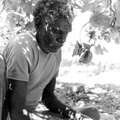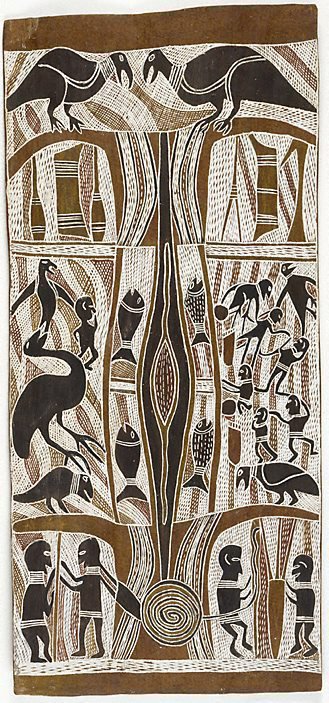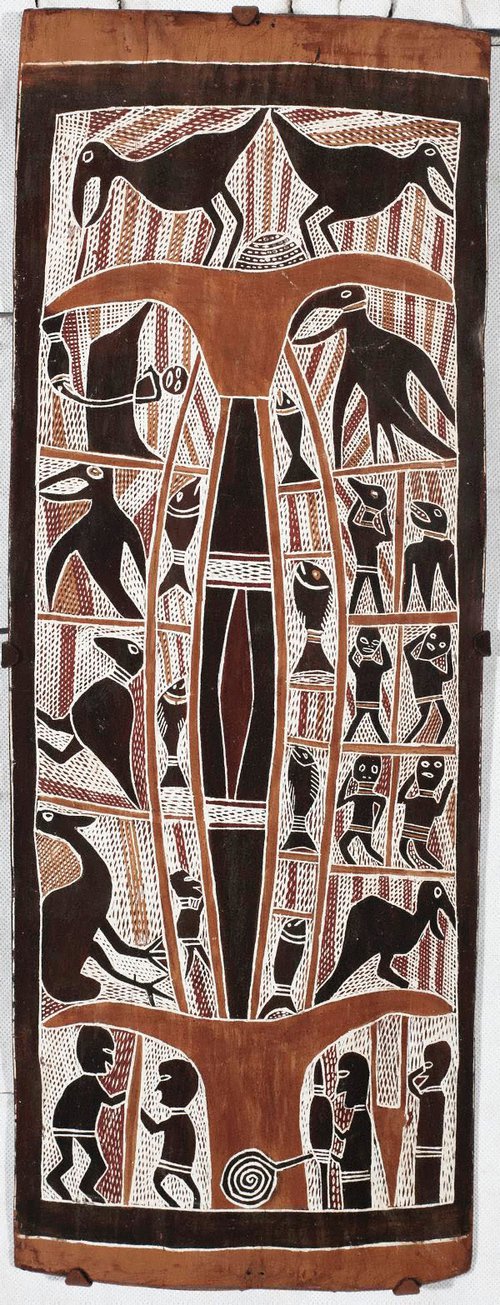Title
Djert (The sea eagle)
circa 1958
Artist
-
Details
- Other Titles
- Djirrt (The sea eagle)
Djirird and Damala - Place where the work was made
-
Yirrkala
→
North-east Arnhem Land
→
Northern Territory
→
Australia
- Date
- circa 1958
- Media category
- Bark painting
- Materials used
- natural pigments on bark
- Dimensions
- 90.0 x 47.0 cm (irreg.)
- Signature & date
Not signed. Not dated.
- Credit
- Purchased under the terms of the Florence Turner Blake Bequest and with funds provided by the Don Mitchell Bequest Fund 1999
- Location
- Not on display
- Accession number
- 137.1999
- Copyright
- © Narritjin Maymuru Estate
- Artist information
-
 Narritjin Maymuru
Narritjin Maymuru
Works in the collection
- Share
-
-
About
Narritjin Maymuru's life encompassed some of the major events of Australian and Northern Territory history. He was a great intellectual and ceremonial leader. Within his community he was often called on to assume the role of mediator, bringing disputants together. Above all he was an artist with a passion for making things. He would work late into the night while his family slept, bent double over a sheet of bark, painting by the light of an unshaded bulb.
Narritjin's earliest surviving paintings and carvings were completed for the anthropologists Ronald and Catherine Berndt in 1946, and in 1948 and 1952 he produced a number of works for Charles Mountford (who led the American-Australian Scientific Expedition to Arnhem land in 1948). During the 1950s Narritjin painted very little, and mainly produced polished hardwood carvings. However, by the early 1960s he had become one of the most prolific and renowned Yolngu artists. In 1962, Narritjin suggested that two great painted panels should be placed on either side of the Yirrkala church altar, and was one of the artists who painted these extraordinary works.
In 1963, Narritjin Maymuru and a group of Yolngu dancers performed in Sydney and Melbourne, in a tour organised by the Elizabethan Theatre Trust, and a solo exhibition of Narritjin's paintings was also held in Sydney. Narritjin developed a close relationship with the Melbourne art dealer Jim Davidson, and his art became well represented in museums and galleries in Australia and overseas, in particular in the United States. In 1978, with his son Banapana, Narritjin was jointly awarded a Creative Arts Fellowship from the Australian National University, Canberra.
Narritjin Maymuru was an innovative artist, although he always worked within the canons of Yolngu art. His paintings are known for their complex symbolism. Many of them represent ancestral stories in narrative form, and symbolic connections are often conveyed by subtle visual puns. Similar elements occur across the paintings, with different but related meanings. Narritjin's art is characterised by its diversity, intricacy and great attention to detail, as seen in 'Djert (The sea eagle)', c.1958. Yet within his corpus there are also works of profound simplicity, in which he condenses imagery into key motifs. Narritjin Maymuru saw art as a means of communicating ideas and knowledge to an audience outside his community as a means of widening understanding of Yolngu culture, and to younger generations of Yolngu as a way of ensuring the continuity of their ancestral law.
Howard Morphy in in 'Tradition today: Indigenous art in Australia', Art Gallery of New South Wales, Sydney, 2004
© Art Gallery of New South Wales
-
Places
Where the work was made
Yirrkala
-
Exhibition history
Shown in 1 exhibition
Aboriginal Art of the Top End, National Gallery of Victoria [St Kilda Road], Melbourne, Oct 1988–Dec 1988
-
Bibliography
Referenced in 3 publications
-
Art Gallery of New South Wales, Art Gallery of New South Wales Annual Report 2000, 'Year in review', pg. 8-20, Sydney, 2000, 10.
-
Howard Morphy, Tradition today: Indigenous art in Australia, 'Narritjin Maymuru', pg. 86, Sydney, 2004, 86, 87 (colour illus.).
-
National Gallery of Victoria [Swanston Street] (Compilator), Aboriginal art of the top end, Melbourne, 1988, 19. Note that this work is refered to by a different title in this publication "Djirird and Damala".
-


